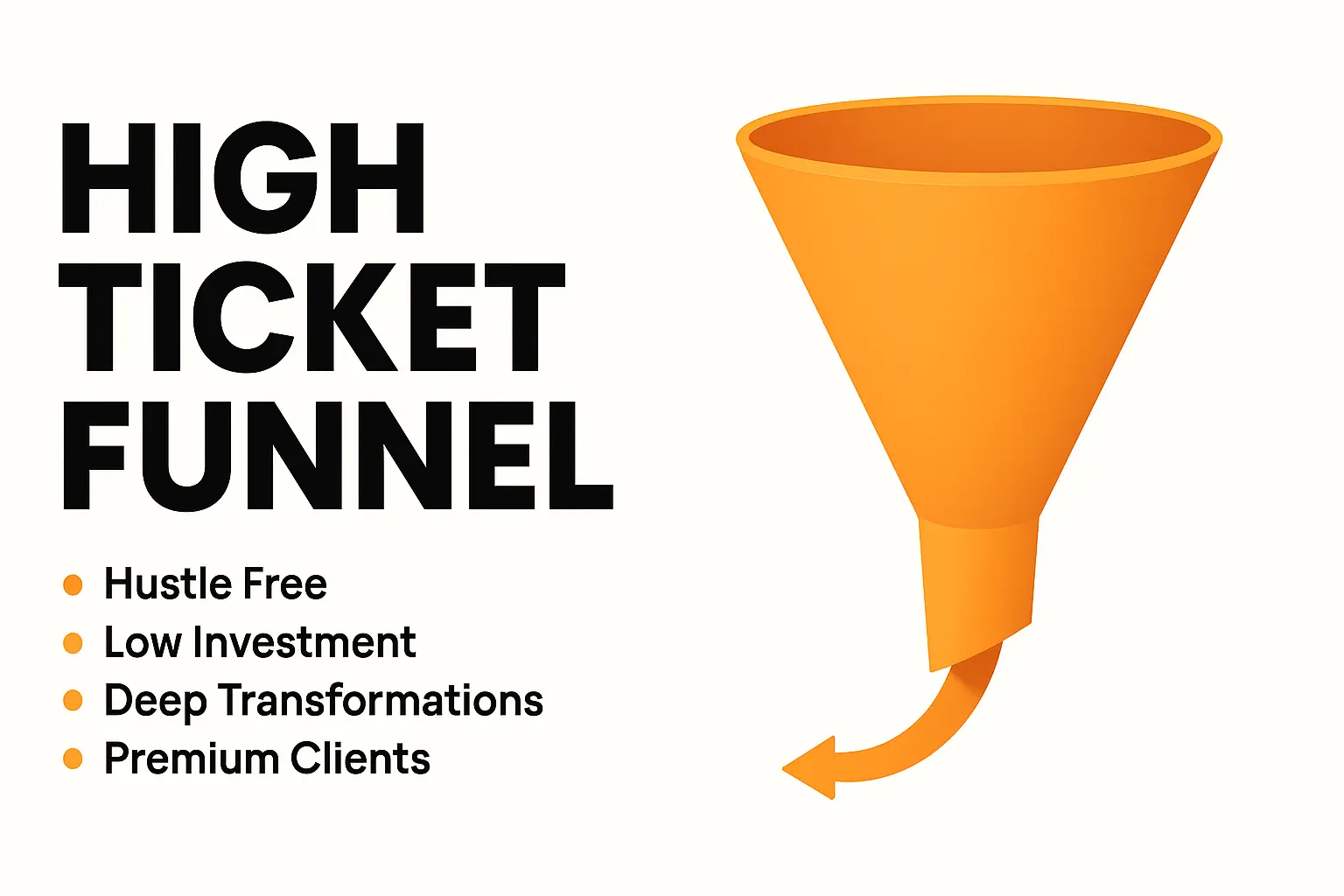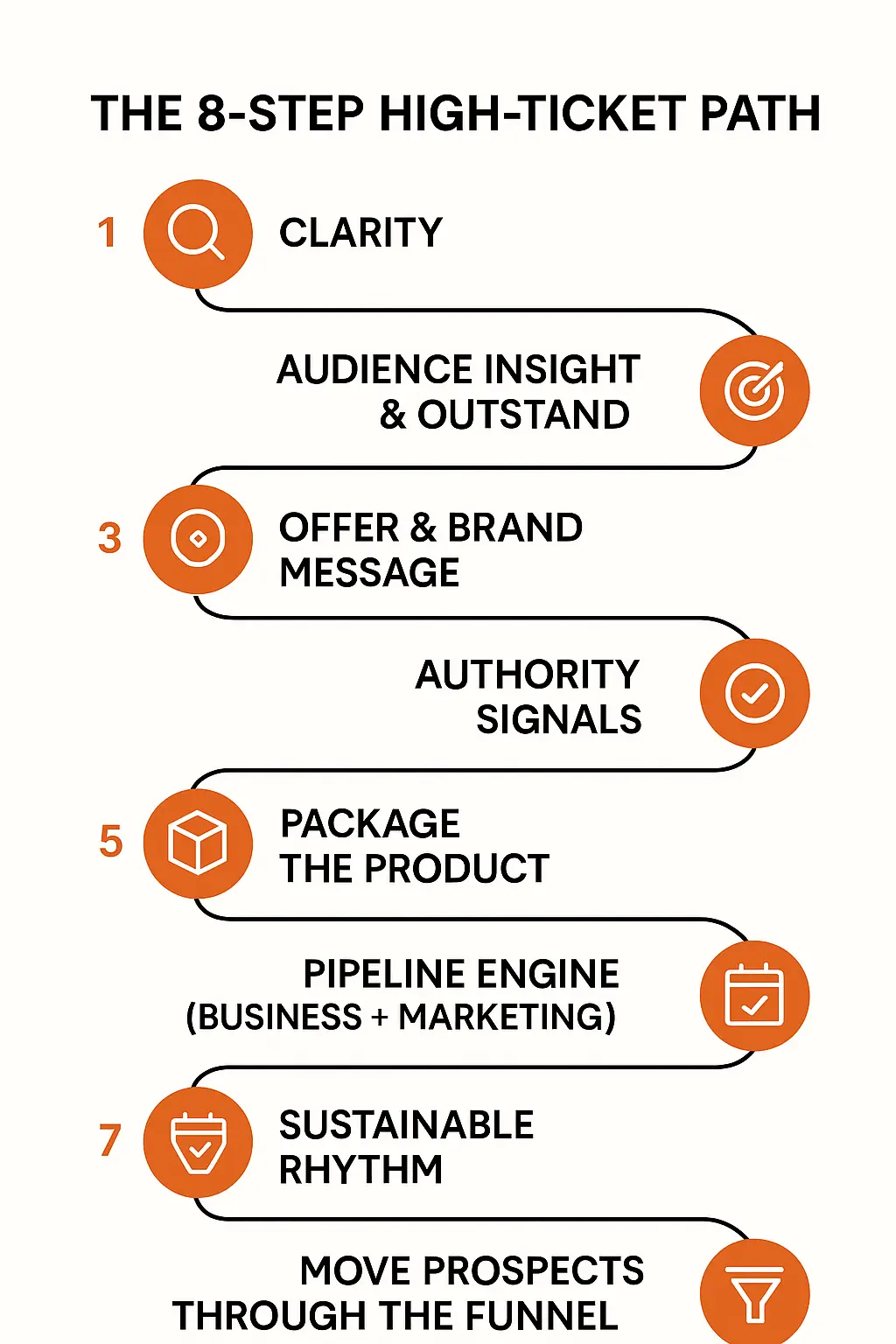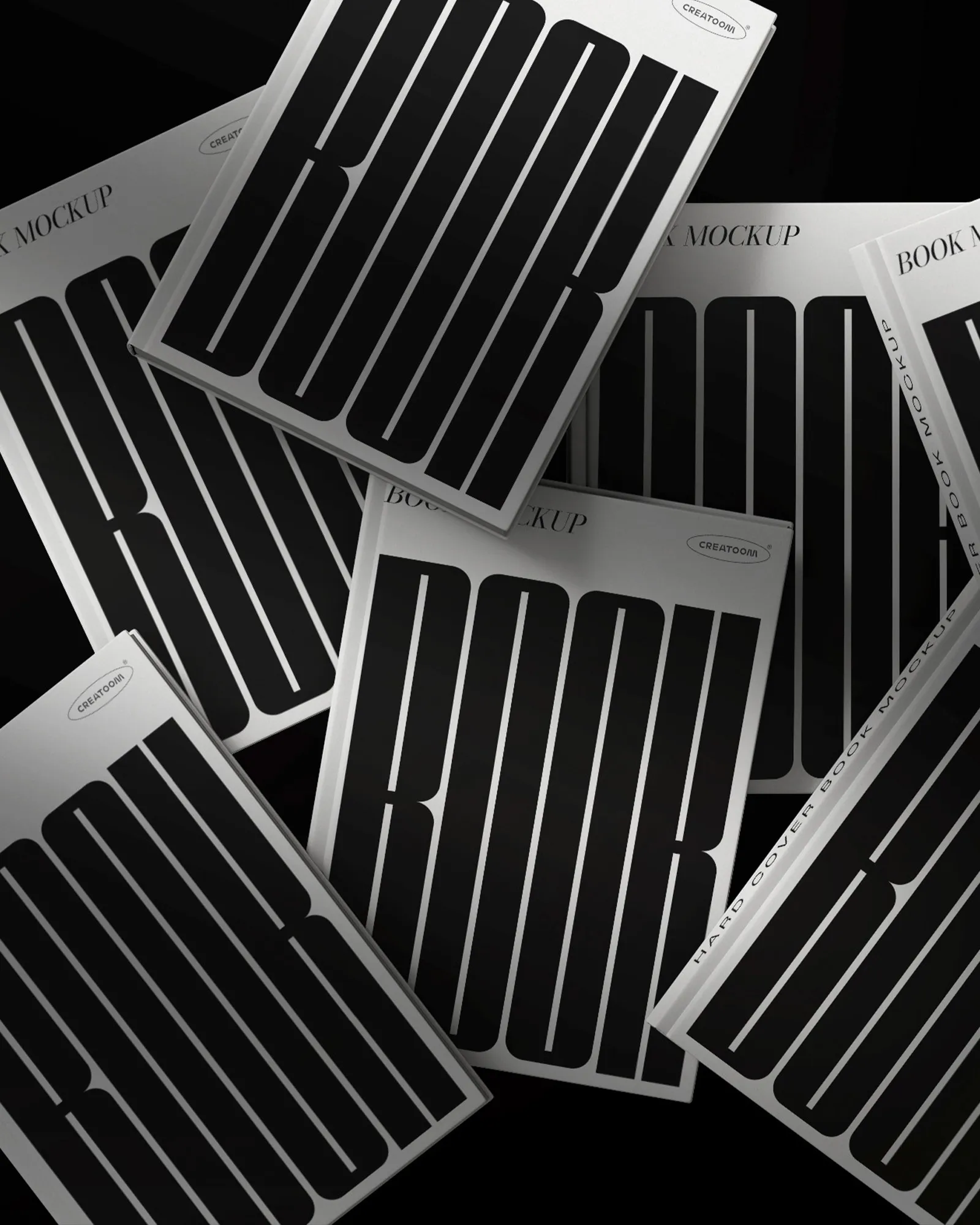
A high-ticket client funnel is a value-driven marketing path designed to attract a premium, transformation-seeking audience—people who recognise your program’s worth and can commit to deep work.
It’s non-coercive: clear positioning, a transformative offer, visible proof, a concise explanation of how the program works, and a simple call-to-action that invites a 1:1 engagement.
1. Clarity: who you serve, the core problem, and how you serve.
2. Audience insight & outstand: learn their pains and say what they already feel.
3. Offer & brand message: shape the transformation + one-line promise.
4. Authority signals: case notes, outcomes, signature asset, short explainer video.
5. Package the product: scope, milestones, inclusions/exclusions, price, “who it’s for/not for.”
6. Pipeline engine: shows up when story + promise + channels say the same thing; markers: message agreement across channels and calm energy allocation.
7. Sustainable marketing rhythm: simple, repeatable content carrying the same message.
8. Move prospects through the funnel: awareness → consideration → conversion → loyal, with the same message across channels.
Why great products still don’t sell
You built something that works. It changes people. But it only becomes success when it reaches the right people—and that takes a little marketing, used wisely.
You might be stuck at low-ticket because the wrong audience keeps showing up. A life coach prices fairly and delivers depth, yet attracts bargain hunters who want tips, not change. They don’t see the value, so calls end in “I’ll think about it.”
Your messaging doesn’t show the transformation, only the parts. A health coach talks protocols and features—meal plans, metrics, trackers—while the client is buying “I can play with my kids again.” The promise is there, but hidden. Without a clear end state, momentum stalls.
There’s no pipeline that warms the right people. A spiritual coach posts thoughtful content, but there isn’t an intake that filters for intent or a simple path to a call. Interest floats away. Good conversations never happen.
A high-ticket client funnel fixes this by tightening who you speak to, naming the change they actually want, and giving them a clean path to talk.
- From “anyone” to “the one.”
- From scattered posts to a steady, low-friction path to a call.
What is High-Ticket funnel?
A high-ticket funnel is a value-driven marketing path designed to attract a premium, transformation-seeking client—the kind of person who recognizes your program’s worth and commits to deep work. It’s non-coercive. You state a clear promise for a specific person, show visible proof, explain how the program works in plain language, and offer a simple invitation to a 1:1 conversation. The goal isn’t volume; it’s fit, depth, and outcomes.
In practice: it feels like clarity. One promise. One person. One path. Your page reads like a confident guide, not a pitch. Your calendar fills with people who already believe change is possible—and are ready to do their part.
Who it’s for
- Coaches who value depth over reach and prefer fewer clients with bigger outcomes
- Practitioners willing to own one promise for one specific person
- Professionals ready to publish visible proof (case notes, outcomes, process)
- People who hold clear boundaries (scope, timelines, “who it’s for / not for”)
- Those comfortable pricing the cost of transformation, not hours
Who it’s not for
- Broad “everyone” offers where the finish line can’t be named
- Creators chasing fame, followers, or volume over outcomes
- Programs that avoid publishing proof or defining scope
- Engagements that rely on discounts to close
- Teams unwilling to keep a simple weekly rhythm (even 90 minutes)
Before we build, a promise: if the right person lands here and sees themselves—clearly—in your promise, your proof, and your path, momentum begins. If you’re nodding, the next eight steps will give you a simple way to turn attention into booked calls, without turning you into a full-time marketer.
Step-by-Step Guide to Create a High-Ticket Process & Pipeline

Step 1 — Clarity: the decision that makes marketing lighter
If you’ve changed products, swapped funnels, posted more, and still sit in the same place, odds are you’re missing foundational clarity. Not a new hack—clarity about how you want your work to unfold, who you’re willing to serve deeply, and the rules of engagement that protect your energy.
Clarity is choosing:
- Whom you’ll transform (one person you can help best).
- What you’ll change (one core problem → one promised outcome).
- How you’ll deliver (1:1, small group, hybrid), with firm boundaries (what’s in, what’s out).
- Your horizon (what scale looks like six months from now—cadence, capacity, price band).
When this snaps into place, tone, message, and pricing stop wobbling. You coach more. You post less. And leads stop feeling random.
Do this (15 minutes):
Write one page called The Way I Work.
In plain language, answer: Who is this for? What changes in 90 days? How do we do it? What’s not included? How many clients can I hold? End with a single line: “I help [WHO] achieve [OUTCOME] in [TIMEFRAME] without [BIG COST].”
Example (Spiritual coach):
“I help senior leaders dissolve persistent anxiety in 12 weeks without long daily practices—through weekly 1:1 sessions.”
Clarity is a pillar. Without it, every marketing move feels heavy—and expensive. With it, the rest of the funnel becomes inevitable.
Step 2 — Audience insight & outstand: say the thing they already feel
Once you know your lane, learn your person—deeply. Not demographics. Decisions. What hurts today? What have they tried? What would a good week look like if the problem were gone? Which words do they use when they describe stuckness?
Balance matters: too broad and you disappear; too narrow and you starve. Aim for a reachable niche—specific enough to feel seen, large enough to sustain your pipeline.
To outstand (not just stand out), mirror their inner dialogue and name the finish line in their language. Your job is to make the promise obvious and the next step small.
Do this this week:
Ask past clients or ideal prospects:
- “What were you trying to fix when you first looked for help?”
- “What have you already tried? What almost worked?”
- “If this worked, what would change first?”
Copy their phrases verbatim into your notes; those words become your headings, emails, and on-page copy.
Example (Health coach):
Clients don’t buy “protocols”; they buy “breath without wheeze on stairs,” “no evening sugar crash,” “play football with my son on Sundays.” Put that exact line above the fold.
With the right insight and the right words, you’ll outpace louder competitors—quietly. Next, we’ll shape this into your Offer & brand message so the transformation feels concrete and worth the price.
Step 3 — Offer & brand message (the core promise)
Your offer is the moment of truth: say exactly what you do, for whom, and what changes—so it lands.
Templates can help you get there, but they’re scaffolding, not the house. Try them, then speak like a human:
- Template to draft: I help [WHO] achieve [OUTCOME] in [TIMEFRAME] without [BIG COST].
That’s the offer. Your brand message is the heartbeat around it: the tension you name, the empathy you hold, and the bridge you offer from where they are to where they want to be.
Create the right tension:
Name the felt problem without drama. “You’re doing everything right—and your energy is still leaking.” Then show the bridge: “Here’s what changes first, week by week.” The reader should feel seen, not sold.
Prove the fit, repeatedly:
Tell one promise, many ways. A 90-second explainer. A one-page offer sheet. A short teardown of a common mistake. A before/after diary. Same truth, different angles. Consistency builds memory; memory builds trust.
Make it stick everywhere:
The same promise, the same words, in the same order—on your homepage, videos, articles, emails, and even how your team replies in DMs. When the message is consistent, decisions get easier (for them and for you).
Write a one-page Offer Sheet with: who it’s for, what changes in 90 days, how it works, what’s not included, price band, and a simple “who it’s not for.” Then distill a one-line promise for the hero of your site.
Step 4 — Authority signals (make trust visible)
If you do the work, authority is already there. Your job is to show it in ways people can quickly scan and believe.
Start small, keep it real:
- Mini case notes: problem → process → outcome → one sentence from the client.
- Outcome snapshots: one metric, one behavior change, one quote.
- Signature asset: a short framework or teardown that only you could write.
- Light video: 60–90 seconds explaining how the program works and who it’s for/not for.
Thread these into your funnel: above the fold (one outcome), mid-page (two mini notes), near the CTA (risk reversal + “what happens first week”). In calls, bring them to life with specifics: “By week two, you’ll have X; by week four, Y.”
Authority isn’t loud. It’s precise. When your proof, offer, and message line up, price starts to make sense—and the right clients lean in. Next, we’ll package the product so the value is obvious before the call.
Step 5 — Package the product (make the value obvious)
Great coaching can feel invisible from the outside. Packaging makes it visible—so a stranger can glance at your page and think, “I see the path. I see myself on it.”
Start with an MVP: the simplest version that still delivers the transformation. Then lay it out as clean, clear steps. Name the milestones a client will cross, what’s included, what’s not, and how you’ll know it’s working. This isn’t decoration; it’s integrity. When the journey is legible, price becomes a conclusion—not a surprise.
Speak in their language. Use examples and small metaphors they already live with. Instead of “Module 2: Cognitive Reframing,” try “Week 2: the first night you sleep through.” Keep the words concrete; keep the promise measurable.
High-ticket is premium because it carries depth, responsibility, cadence, and attention. Your packaging should reflect that: boundaries, availability windows, response times, progress reviews, and a clear “who it’s for / not for.” Add delighters that show care without inflating scope—a kick-off checklist, a mid-week 10-minute check-in, a small “win tracker” they can see grow.
- What to include: scope, milestones by week/month, success metrics, tools you’ll use, access rules, what’s out of scope.
- Pricing: anchor to the cost of staying stuck and the value of the outcome. Offer a sane payment plan; don’t discount the transformation.
Draft a one-page “Journey Map.” Title the 3–5 steps in plain words, write one outcome sentence per step, list inclusions/exclusions, and add a price band. End with a box: Who it’s for / not for. Read it aloud—if it sounds like you, you’re close.
Step 6 — The Pipeline (what reveals itself when things line up)
A pipeline isn’t a tool; it’s a consequence. It shows up when business clarity stops wobbling. Clarity decides the hill you’ll stand on and the people you’ll stand with. That decision turns into messaging—a sentence a stranger can recognize as theirs. Only then does marketing have something to carry: not noise, but the same promise, repeated on purpose.
When those parts align, you don’t “build a pipeline”—you start to see one. Channels stop behaving like separate hobbies and begin acting like a team. A podcast mention, a LinkedIn post, a referral email: different doors, same room. The language matches, the finish line is the same, and the invitation is clear. What used to feel like chasing becomes continuity—attention → conversation → decision—because every touch says the same true thing.
Two deeper markers tell you the pipeline is present:
- Agreement across channels. The words match. The end state matches. The reason to act now matches. This is narrative integrity, not volume.
- Calm allocation of energy. You can name the next sensible investment (ads, partnerships, patience) because you know which part of the story is underpowered. Money becomes a lever, not a life raft.
Agencies and freelancers can add muscle, but without the spine (clarity → message → aligned channels) they lift in different directions. The pipeline isn’t “installed.” It emerges when the story, the promise, and the path point the same way.
Step 7 — Sustainable Rhythm (the beat that matches your intent)
Rhythm is strategy made visible over time. It’s not a hack or a posting quota; it’s a promise kept at a pace you can keep.
Three lenses give it depth:
- Intent: Are you establishing (be unmistakable), stabilizing (be predictable), or scaling (be the same story, louder)? The tempo follows the intent.
- Identity: One idea at a time. People remember you for the sentence you repeat, not the list you complete.
- Infrastructure: A living library of your own words—client phrases, objections, before/after lines. AI can help organize, repurpose, and remind. Your voice stays human; the workload gets lighter.
A sustainable rhythm looks quiet from the outside: simple beats, long game. Inside, it’s disciplined: the same message crossing the same finish line, week after week. That’s how trust compounds. Consistency isn’t “more content.” It’s the same truth, reliably delivered.
Step 8 — Movement Through the Journey (awareness → consideration → conversion → loyal)
Think of the journey as a thread that doesn’t break.
In awareness, someone hears a line that finally names their lived problem. The feeling is relief, not pressure.
In consideration, they recognize themselves in a real story and borrow your confidence long enough to imagine the finish line. Proof isn’t noise here; it’s orientation.
In conversion, the path feels short and the decision feels fair. Scope, milestones, and price read like a plan, not a gamble.
In loyal, the transformation becomes their story. Not because you asked for it, but because the change is now part of how they introduce themselves.
Depth check for each stage:
- Awareness: Is the promise legible in one breath?
- Consideration: Can they see “someone like me” succeed?
- Conversion: Does the next step feel obvious and safe?
- Loyal: Is there a natural place where their story returns to fuel the next one?
When clarity leads, message aligns, and rhythm holds, each stage hands the baton to the next without drama. That’s momentum. Not forced, not fragile—just the natural result of a pipeline that exists because the pieces finally agree.
You’re a Coach, Not a Marketer (gentle pitch)
Your calendar should prove it. The work you do is depth work—quiet, exacting, personal. The machine that brings the right people to your door is different work. It’s architecture. It’s maintenance. It’s making a dozen small parts agree on one simple promise.
Keep your rhythm. Keep your voice. Let someone else line up the gates, keep the story consistent, and tune the spend only when the story is ready. That’s not abdication; it’s stewardship. You coach. We make the path to you feel short and fair.
Find the story you’re truly telling—and the standards you won’t compromise.
Uncover your core archetype and 3–5 values, with simple cues for voice and headlines.
Use it to align your site, offers, and emails so you sound like you—everywhere.
Discover Your Brand Archetype & Values
FAQs
What does “high-ticket” usually mean for coaches in India/UK?
It’s less about the number and more about the depth. In India, many premium 1:1 programs sit roughly in the ₹75k–₹2.5L range; in the UK, £1.5k–£6k is common. The right fee reflects the size of the problem, the certainty of the path, and the attention you bring—not the length of the sessions.
Do I need a big audience before I try high-ticket?
No. A clear promise, visible proof, and a short path to a call matter more than follower counts. A small, relevant audience that recognizes itself in your message will outperform a large, general one.
What if I don’t have testimonials yet?
Start with outcome notes from pilot clients—short, factual, and specific. “Came in with X, we did Y, now they can Z.” One honest result written clearly is more useful than a paragraph of praise with no details.
How do I decide my price without second-guessing?
Anchor to the cost of staying stuck and the value of the first concrete milestone. Price the transformation, not the hours. Offer a sensible payment plan if cash flow is the concern; avoid discounting the promise itself.
Is group work or 1:1 better for high-ticket?
Both can work. If your process is still being refined, 1:1 gives speed and certainty. Group becomes powerful once outcomes are repeatable and peers can help each other advance through the same milestones.
When should I consider ads?
After your message is legible in one breath, your proof is public, and your path to a call is tidy. Ads amplify what already works; they don’t repair a wobbly promise. Give yourself a realistic runway to learn.
What’s the simplest way to know my pipeline is healthy?
You can describe the journey in a few steps, and each step has a clear next action. Leads feel like continuity, not surprises. You spend more time coaching than explaining what you do.
How do I keep marketing from taking over my week?
Choose a rhythm that matches your stage—establishing, stabilizing, or scaling—and keep one core idea alive at a time. Use tools (including AI) to repurpose and organize, but keep the judgment human. Consistency is the same truth, delivered reliably.
What if I attract the wrong audience?
Tighten the “who it’s for / not for” box and bring one outcome to the top of the page that your best clients care about most. Misfit leads drop quickly when the edges are clear.
How will I know this approach is working?
Conversations feel warmer, calls feel shorter, decisions feel fair. You’ll notice fewer objections about price and more questions about timing. That’s the sign your promise, proof, and path are finally agreeing with each other.
.png)



